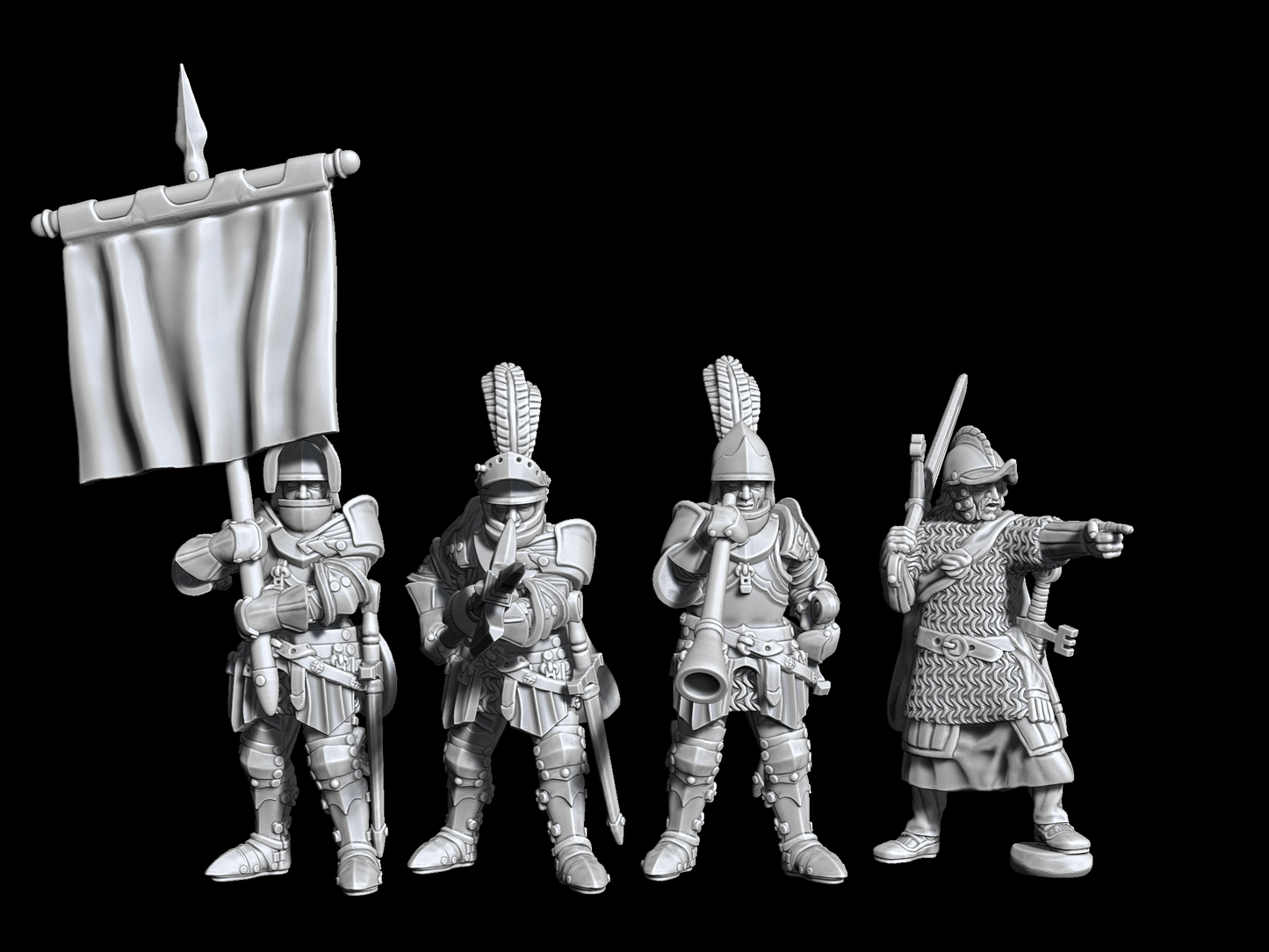Wargames Delivered
Anglo-Scots Foot Command STLs
Couldn't load pickup availability

These are DIGITAL files meant for 3D printing. They ARE NOT physical miniatures!
Sculpted by the incomparable Erramir Orlan of Peculiar Companions, this Anglo-Scots Foot Command set is intended for armies from the 15th and 16th Centuries. This set of four 3D models comes with a commander with a halberd and a Gallowglass commander, dismounted drummer and a standard bearer. All models come as both pre-supported and unsupported STL files.
The 15th and 16th centuries were a tumultuous period in the history of the British Isles. The Anglo-Scottish wars, Border Reivers, and internal conflicts provided a rich tapestry of military action. Key battles like Flodden (1513) and Pinkie Cleugh (1547) pitted The Scottish against The English forces in decisive encounters that would shape the destinies of both nations.
Notable English Commanders:
Henry V: Known primarily for his campaigns in France, particularly the Battle of Agincourt, Henry V also had to contend with the Scots, who traditionally sought to take advantage of English preoccupation with France.
Thomas Howard, Earl of Surrey: Led English forces to victory in the Battle of Flodden in 1513, where James IV of Scotland was killed.
Edward Seymour, Duke of Somerset: A key commander in the Battle of Pinkie Cleugh in 1547, part of the "Rough Wooing" campaign meant to force a marriage alliance between England and Scotland.
Lord Hertford (later Duke of Somerset): Involved in burning Edinburgh in 1544, another episode of the "Rough Wooing."
Notable Scottish Commanders:
Archibald Douglas, 4th Earl of Douglas: Known as Tyneman ('loser'), he was a key figure in the Scottish nobility during the 15th century and played a role in Anglo-Scottish warfare. He was killed at the Battle of Verneuil in 1424, fighting alongside the French against the English.
James II of Scotland: Known for his attempts to neutralize powerful nobles and establish a strong monarchy. He also laid siege to Roxburgh Castle in 1460 but was killed when a cannon exploded near him.
Alexander Stewart, Earl of Mar: Led Scots in the victory at the Battle of Harlaw in 1411 against Donald of Islay, Lord of the Isles.
James IV of Scotland: A Renaissance monarch with a keen interest in warfare, especially artillery. He led an invasion into England but was defeated and killed at the Battle of Flodden in 1513.
James V of Scotland: Like his father, he also sought to assert Scottish independence and was involved in various campaigns against England, though often with limited success.
Archibald Douglas, 6th Earl of Angus: Involved in the Battle of Solway Moss, where the Scots were defeated by the English in 1542.
John Stewart, Earl of Lennox: Fought in the Battle of Pinkie Cleugh in 1547, another defeat for the Scots but where he distinguished himself for his bravery.
George Gordon, 4th Earl of Huntly: A powerful noble in the north-east of Scotland, involved in internal and border conflicts.
William Kirkcaldy of Grange: Fought in the Battles of St. Quentin and Gravelines as a young mercenary on the Continent, later played a role in the Scottish Reformation and was a key defender of Edinburgh Castle.
Andrew de Moray: Although more famous for his role in the earlier Wars of Scottish Independence, the Moray family remained significant in Scottish military and political life into the 16th century.
David Leslie, Lord Newark: A cavalry officer who played a significant role during the Wars of the Three Kingdoms, notably at the Battle of Philiphaugh.
Alexander MacDonald, Lord of the Isles: Though technically from the late 14th to early 15th century, the Lordship remained a military power into the 16th century. They were often involved in conflicts against the Scottish crown or as mercenaries in Irish wars.
Printing at 100% resolution will yield a true 28mm miniature. Prints at 105% are slightly more in scale with Perry Miniatures and 110% prints will be in a compatible scale with Warhammer Fantasy miniatures.
Share


